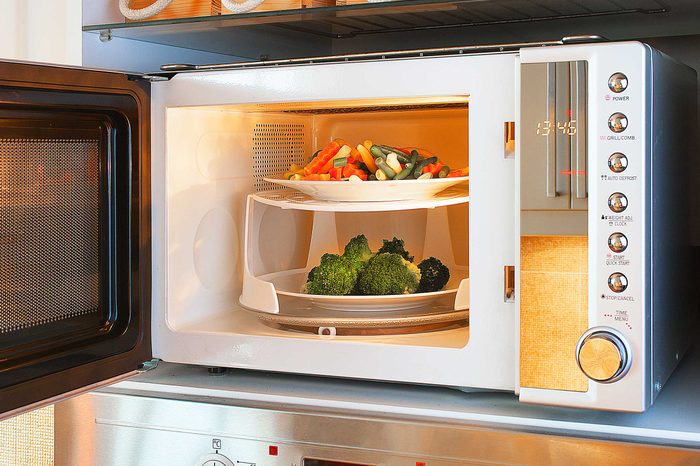
You don’t cook your veggies in it
Believe it or not, the plain old microwave might trump all the chef-y cooking techniques you use to cook your veggies. Vegetables retain their highest nutrient content the less they’re exposed to heat and water. That means nuking your broccoli will preserve more vitamin C and cancer-fighting glucosinolate than pretty much any other method (besides stovetop steaming); plus, it’ll leave you with fewer dirty pans to scrub later. Here are 10 foods even professional chefs cook in the microwave.
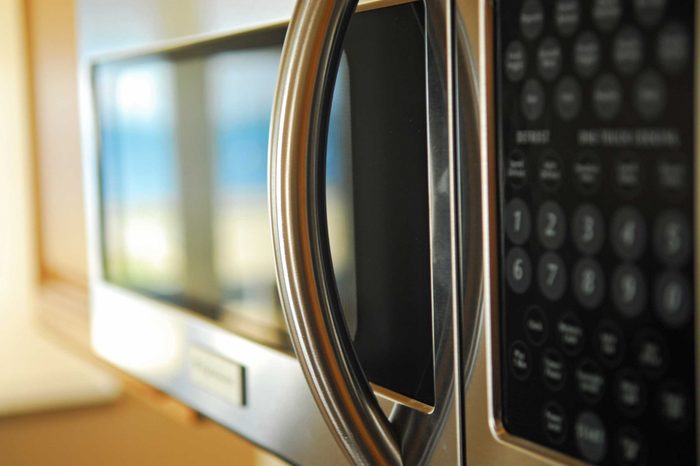
You never use the pause button
If you’re in a time crunch, delaying your microwave meal is probably the last thing you want to do. But pressing the pause button can actually save you a lot of time down the line when you’re not hugging the toilet for hours. It’s important to stir leftovers and ready-to-eat frozen meals halfway through the reheating process; this allows the food to cook evenly and prevents any cold spots from lingering, which are a breeding ground for bacteria that could make you sick.
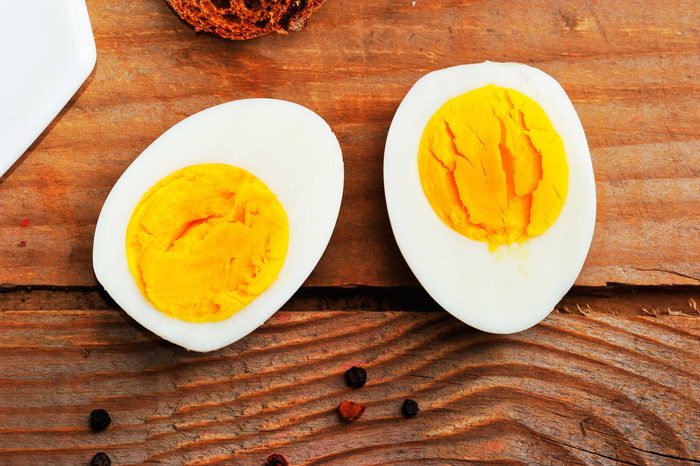
You reheat hardboiled eggs
Never, ever reheat a hardboiled egg still in its shell! Doing so could cause a mini explosion, complete with a loud pop and bits of shell and smelly egg splattered all over the inside of your microwave. Peel the egg first, then gently warm it up. These are other 12 things you should never, ever microwave.

You microwave plastic containers
Unless the container says “microwave safe,” don’t put it in the microwave. Many plastic storage and takeout containers contain chemicals (BPA is one) that some studies suggest may be linked to health problems like diabetes, infertility, and heart disease; they can leach into your food during the cooking process. You’re probably using these 36 household appliances all wrong, too.

You haven’t used it to dry herbs
If you don’t want to wait around for your fresh hanging herbs to dry out when the growing season ends, pop them in the microwave. Sandwich fresh herbs in a single layer between two paper towels. Then microwave in 30-second intervals until they reach your desired dryness.
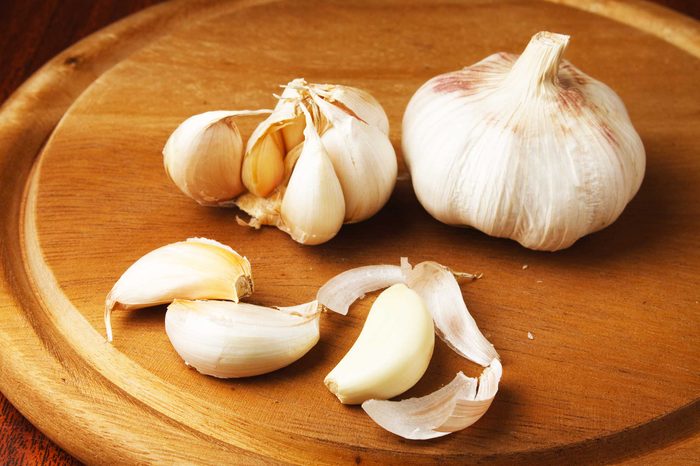
You don’t use it to peel garlic
Say goodbye to tediously peeling clove after clove of garlic. You can microwave a whole head of garlic for about 20 seconds and the cloves will slip out of their peels effortlessly, without the garlic-scented fingers.

You don’t prepare Sunday breakfast in the microwave
Sunday morning breakfast just got a lot easier and cleaner because you can cook bacon and eggs right in the microwave. Lay bacon between two pieces of paper towel or on a covered plate. Microwave in one-minute intervals until it’s the perfect crispiness; not only does it take less time than the stovetop method, it also saves you a greasy mess. You can also cook scrambled eggs and omelets in a microwave-safe bowl. Zap for about one to two minutes per egg; stir halfway through for scrambled. These are the 25 brilliant kitchen shortcuts you need to know.

You don’t know its wattage
Not all microwaves are created equal, and if you don’t know your model’s wattage you could find yourself in trouble. Many premade meals require a certain wattage to properly heat up the food; following the recommended cook time could still leave you with undercooked and possibly contaminated food if you’re not heating it at the proper wattage, too. Most midsized to large microwaves are typically between 850 and 1,650 watts, while more compact ones tend to be between 600 and 800 watts, according to Consumer Reports. If your oven is smaller than what’s printed on the package, heat your food for a little longer to ensure it’s fully cooked. And if you don’t know its wattage, this simple test can help you figure it out.

You’ve never microwaved potato chips
No, don’t dump a bag of chips in a bowl and shove it in the microwave. Make healthy homemade potato chips without ever turning on your oven or the deep fryer. Slice potatoes or sweet potatoes as thinly as possible (carefully use a mandolin if you have one). Spray with cooking oil or brush with olive oil and arrange them in a single layer on a plate. Sprinkle with a bit of salt (and black pepper if you like spice) and heat uncovered for three minutes, then flip and cook for three more. But don’t grab them just yet! It’s important to let them fully cool, since this is when they crisp up into the crunchy bite you know and love. Here are 16 foods you had no idea you could microwave.
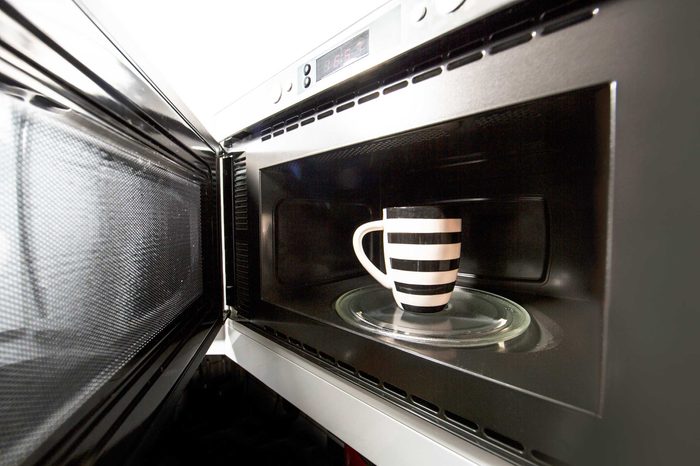
You’re not making microwave lattes
You don’t need a fancy machine to make the perfect latte or cappuccino. Once you brew the espresso on the stove or in a coffeemaker, you can create that creamy finishing foam right in your microwave. Fill a lidded jar about halfway with milk and shake vigorously. Remove the lid and microwave for 30 seconds. Voila! You have warm milk to pour and fluffy foam to scoop on top.

You cover plates with plastic wrap
Covering your food is always a good idea to prevent splattering, but never use plastic wrap; the chemicals from the plastic can get into your food while it cooks. Instead, opt for a moist paper towel to retain moisture or invest in an inexpensive microwave splatter guard, available at most home goods stores. This is exactly how to reheat 6 different leftovers for the best taste.
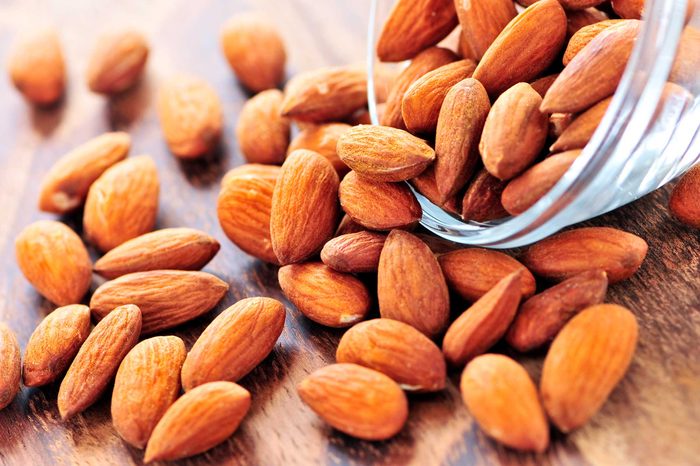
You don’t toast nuts
Toasting nuts has never been so easy. While traditional methods like in a pan or the oven will do the trick, so will your microwave, in much less time and without the scorching. Lay chopped nuts or coconut flakes in a single layer on a plate. Cook in 30-second increments until they reach your desired color, toastiness, and crunch.

You don’t have a regular cleaning schedule
Even if your microwave looks clean, it almost certainly is not. It’s important to regularly scrub the inside and outside of your oven. This eliminates harmful bacteria from raw meat or fish and removes food particles that can be smelly and also harbor bacteria. Pressed for time? Here’s how to clean your entire kitchen in five minutes or less.
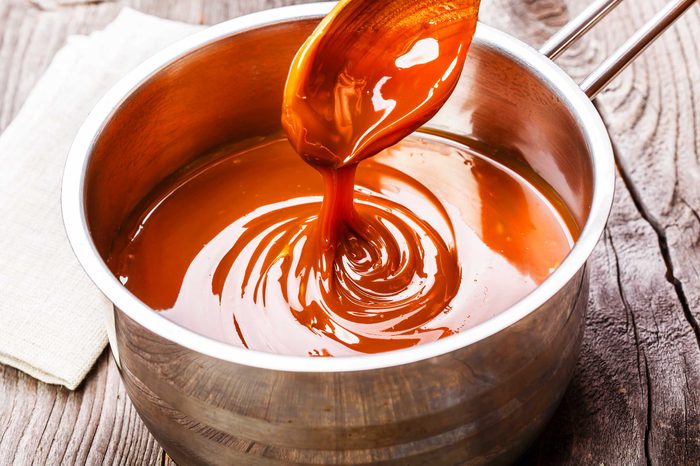
You didn’t know you could make caramel
If you can’t seem to master caramel on the stove (think sticky, burned mess), the microwave is basically foolproof. Pour a can of sweetened condensed milk into a bowl. Cook covered in two-minute intervals, stirring between each one until it’s as caramel-y as you like it. Then indulge.

You defrost meat in its package
Microwaving right in the package might seem like a good way to contain raw meat’s messy and bacteria-laden defrosting juices, but it can actually be more harmful than unwrapping it first. Chemicals from the foam trays meat is sold on and from the plastic packaging can seep into your food as both heat up.

You use it for non-food items
Drying a pair of wet socks or gloves in the microwave isn’t as good an idea as it may seem. Even non-food items that seem harmless can be a potential fire hazard because they may contain flecks of metal or other flammable material that can cause sparks to fly.

You’ve never used it to husk corn
Making corn on the cob just got a lot easier (and a lot less messy). Prevent your kitchen from being covered in those sticky silky hairs by letting the microwave do all the work for you. Cut off the “handle” of the corn cob and microwave the entire thing for two to four minutes, depending on how large your oven it is. Hold the nub of the “handle” with a towel so you don’t burn your hand and gently shake the cob over a disinfected sink or a plastic bag until the corn slips free, fully cooked and ready to gnaw on. Try these 16 foods you didn’t know you could microwave.
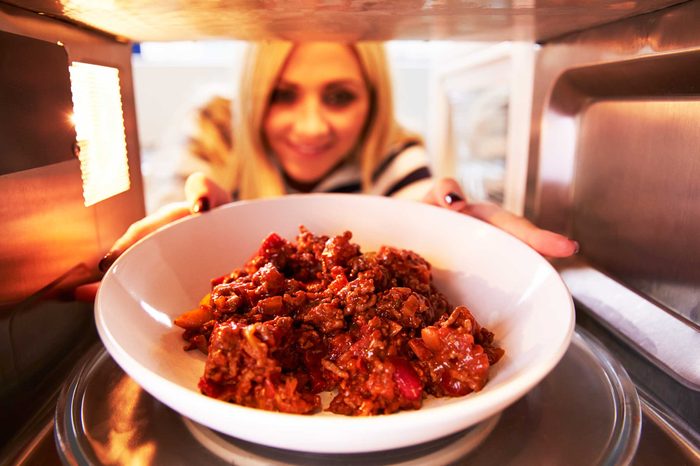
You reheat leftovers with the lid screwed tight
You should always cover your food in the microwave, but the lid should be cracked and never sealed tight. A tightly closed lid can get stuck, making it nearly impossible to open until your food has cooled. And heating up liquid, like soup or coffee, in an airtight vessel can even cause it to explode as it expands during the heating process. These are the 50 kitchen mistakes you’re probably making.